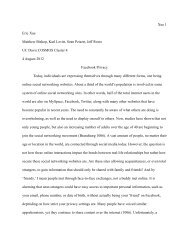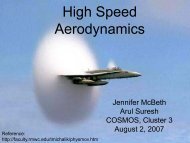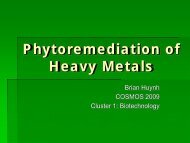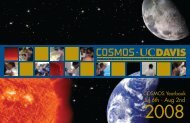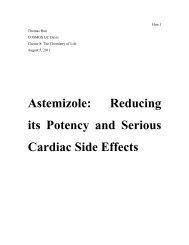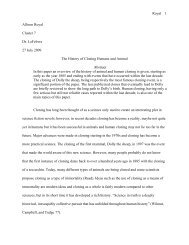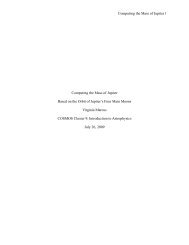TRANSONIC AIRFOILS - COSMOS
TRANSONIC AIRFOILS - COSMOS
TRANSONIC AIRFOILS - COSMOS
You also want an ePaper? Increase the reach of your titles
YUMPU automatically turns print PDFs into web optimized ePapers that Google loves.
History• Issues with airplanes at transonic speeds first occurredwith early planes Tip of propeller could reach supersonic speeds duringsharp‐breaking turns. This caused undesirablebuffeting (note that only the prop became supersonic,not the airplane)• Around WWII (~1940), planes were approaching such fastspeeds that in dives they would enter transonic speeds.This would either destroy the planes or cause undesirableeffects such as control reversal, leading to the popularbelief that the speed of sound was indeed a ‘barrier’• Bell X‐1 was the first plane to officially break the soundbarrier without losing control or breaking apart
Sound Barrier• Steep rise in drag led to false popular belief that the sound barriercouldn’t be brokenone of the popular analytical methods for calculating drag at highspeeds, the Prandtl‐Glauert rule, predicts an infinite amount ofdrag at Mach 1.0.• The laws of subsonic aerodynamics are different from those attransonic speeds. At transonic speeds, flight becomes unstable.At low speeds, airfoils can produce large lift with little dragAt Mach 0.7 –0.8, large increases of drag occur, and flow oftenbecomes unsteady
Shockwaves• When an object moves through h air, it creates a seriesof pressure waves which travel at the speed ofsound. As the object approaches Mach 1, the wavesbecome compressed, causing a shockwave1) subsonic 2) Mach 1 3) supersonic 4) shockwave
Effect of Shockwaves onAirfoils• At a certain point, the speed of airflow ifl willexceed the sound barrier in a ‘local’ region ofthe airfoil (usually the upper surface). Whenthe sound barrier is broken, a shockwave willoccur which terminates the supersonic flow,causing it to slow to subsonic flow.• Sudden rise of pressure in going throughshock often causes boundary layer toseparate, drag to increase, and flow tobecome unstable
Solutions to the SoundBarrier Problem• Supercritical airfoil• Swept wing• Variable‐sweep
Supercritical Airfoil• As shock waves get stronger and move farther aft on the airfoil, boundaryseparation occurs. Airfoils which mitigate or avoid these effects areconsidered ‘supercritical’.• Supercritical Airfoils utilize these design concepts:Carry as much lift as is practical on the aft (rear) potion of the sectionwhere the flow is subsonic.As opposed to standard subsonic airfoils with high camber on the uppersurface, supercritical airfoils have relatively flattened upper surfaces andhighly curved aft sections.Maximum thickness close to the leading edge and enough length toslowly l shock the supersonic speeds back to subsonic.Low camber to increase drag divergence (speed at which wing dragincreases due to shockwaves)
Supercritical Airfoil• Can achieve higher h speeds before flowseparation• Greatly reduces shock‐induced dboundarylayer separation• Allows for more efficient wing design (thickerwing and/or reduced wing sweep, resulting ina lighter wing)
Swept WingA t i i if il ith i t t i ti• A swept wing is airfoil with a wing root to wingtipdirection angled beyond (usually backwards) the spanwiseaxis, used to delay the drag rise caused by fluidcompressibility.
Swept Wing• In the 1920’s Italy produced d the fastestairplanes in the world.• Under Mussolini, the Italian government hld heldan international meeting concerned with theproblem of high‐speed h flight (1935 VoltaCongress)• At this meeting, Adolph Busemann presented tdhis theory of the effect of sweep in reducingthe drag of a wing at supersonic speed.
Swept Wing• This shape allows for very low curvature, anda very thin airfoil. The result is that sweptwing airfoils can fly more efficiently attransonic speeds.Th if il t h l h d• These airfoils must have a long average chordto maintain lift.
Disadvantages of Swept Wing• Low lift coefficienti• Poor performance at low speed Very dangerous for landing situations
Variable SweepF-14 Tomcat. Above: Swept. Below: UnsweptBell X-5. Multiple exposureto demonstrate several wingpositions
Variable Sweep• A type of variable geometry airplane When wings are ‘unswept’, the plane performswell at subsonic speeds When speed approaches Mach 1, the airfoil can beswept to harness the efficiency of swept wings attransonic speed.• Since airplanes with variable sweep canperform well at low and high speeds, they areprimarily used for military airplanes.
Rudolf Julius Emanuel Clausius• Considered to be one of the central foundersof the science of thermodynamics• Introduced the concept of entropy
Thermodynamics• Clausius was a theoretical ti physicisti • 1850, his most famous paper Uber die bewegende KraftderWarme e(O (“On the Moving Force oceof Heat and dthe Lawsof Heat which may be Deduced Therefrom”) waspublished, which quickly made him known in thescientific world.“... Clausius first stated the basic idea of the second law ofthermodynamics. He used it in showing that for a 'Carnot cycle',which h transmits heat between two heat reservoirs at differenttemperatures and at the same time converts heat into work, themaximum work obtained from a given amount of heat dependssolely upon the temperatures of the heat reservoirs and not uponthe nature of the working substance.”
Disproving Caloric Theory• Clausius replaced the previous assumptionconcerning heat (used by Laplace, Poisson,Carnot, and Clapeyron) called caloric theory• Caloric theory consisted of two axioms 1) heat in the universe is conserved 2) heat in a substance is a function of the state ofthe substance• Clausius replaced these axioms with versionsof the first two laws of Thermodynamics, stillused today.
1 st Law of Thermodynamics• Equivalence of heat and work. Wheneverwork is done by heat, an equivalent amountof heat is consumed Experimental evidence done by Joule, not Clausius This law immediately disproved the 2 axioms ofthe caloric theory Basic equation• dQ = dU + dW ‐‐ Q = heat, U = Energy, W = work• “..the merit of first establishing [Sadi Carnot’stheorem] upon correct principles i is entirelydue to Clausius” ‐Thomson
2 nd Law of Thermodynamics(Clausius’ Early Version)• Heat tends to flow from hot to cold bodies
Free and Latent Heat• Free heat ‐ Clausius interpreted this as thekinetic energy of the particles of the body. i.e. Work to K.E. would increase temperature• Latent heat (heat of transformation) ‐ heatdestroyed in work performed against forcesbetween moleculesl
Entropy• From Greek en‐tropein‐ “transformationcontent”• Clausius recognized this as the quantitywhich remains invariant during changes involume and temperature t in a Carnot cycle.• He formulated the rudiments of the theory ofthe measure of transformation ti equivalencehe later called entropy
References• "Clausius biography." Welcome to the Turnbull Server. N.p., n.d. Web.28 July 2010. .• Jones, Robert T.. Wing Theory. Princeton: Princeton University Press,1990. Print.• "NASA ‐ Past Research Projects." NASA ‐ Home. N.p., n.d. Web. 28July 2010../ t /d d /hi t / t t /• "Theory of Flight." MIT. N.p., n.d. Web. 28 July 2010.http://web.mit.edu/16.00/www/aec/flight.html.• Transonic Aerodynamics: Problems in Asymptotic Theory (Frontiers inApplied Mathematics). Ciudad: Society For Industrial Mathematics,1987. Print.• "Wikipedia, the free encyclopedia." Wikipedia, the freeencyclopedia. N.p., n.d. Web. 28 July 2010..




